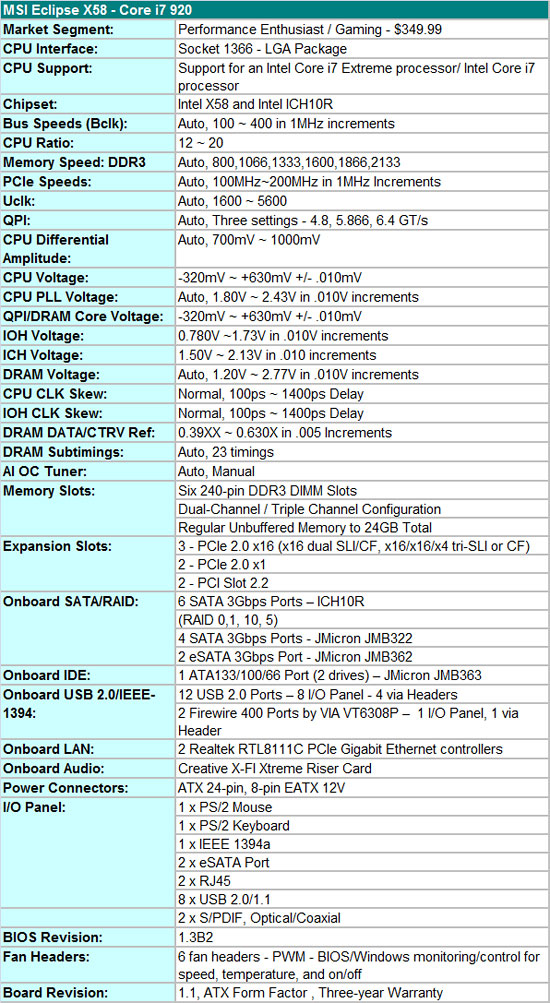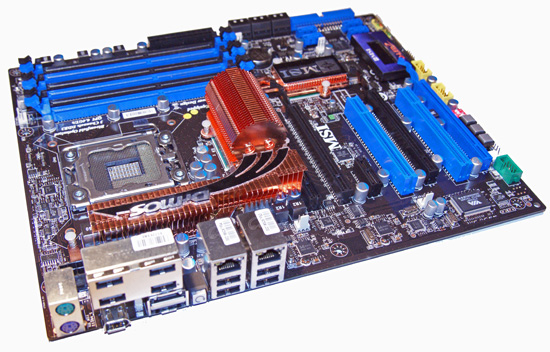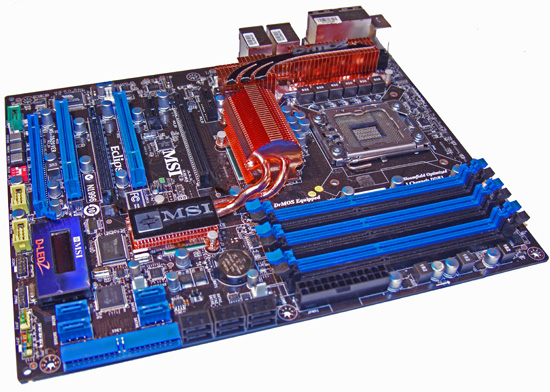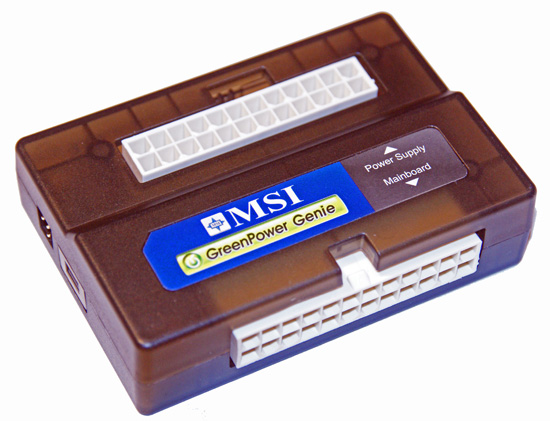Intel X58 Motherboard Roundup - What does $300 Get You?
by Gary Key on December 5, 2008 3:00 PM EST- Posted in
- Motherboards
MSI Eclipse X58
Features

The MSI Eclipse X58 is a feature laden board from a hardware and software viewpoint. It should be considering the $350 price tag, although there is a $30 mail-in-rebate at present. The almost universal Realtek RTL-8111C PCIe Gigabit Ethernet controllers are utilized in tandem; a riser card featuring the Creative Lab's CA0110-IBG chipset provides HD audio and EAX 5.0 capabilities; JMicron’s JMB 363/362/322 chipsets are tabbed for eSATA, IDE, and additional SATA port duties; VIA's VT6308P provides IEEE 1394a support; and the Intel ICH10R is utilized for primary storage purposes.
The BIOS is designed for overclocking duties, although it's not as comprehensive as those from ASUS or Gigabyte. However, it is fair to say that several of the options that ASUS and Gigabyte provide will never be touched by about 95% of us when overclocking. Our main knock against the BIOS is that it is not as user friendly as the others in this roundup. We do not care for the +/- voltage settings as it becomes confusing for the user to understand exactly what effect their changes had on the particular option, especially without knowing what the base voltage is set at.
MSI supports stock memory speeds up to 2133MHz on the i920/i940 processors along with opening up QPI link speeds from a standard 4.800 GT/s up to 6.400 GT/s, which is standard on the i965 Extreme processor. The board fully supports 24GB of DDR3 memory. We have a 24GB kit arriving shortly for testing so we cannot confirm compatibility yet, but we trust MSI in this regard.
In the meantime, we have not had any problems running 12GB with our Patriot or G.Skill DDR3-1600 kits up to 1600 at 9-8-8-24 1T timings, although we needed about 1.68V for absolute stability with the i920 at stock speeds. Dropping the command rate to 2T allows 1.64V operation with the current BIOS. Overall, memory performance is very competitive with the other boards and improving in each BIOS release. However, this is the only six slot board that we have been unable to clock a 12GB configuration up to a 191x21 setting. The board stops around a 175 Bclk with an 8x memory multiplier that results in a DDR3-1528 speed. The board will clock up to a 191 Bclk with the memory multiplier at 6x, which results in a DDR3-1146 setting. MSI is working on improving this area.
The Eclipse board contains three PCI Express 2.0 x16 slots that operate in x16/x16 mode for 2x SLI/CF. The third x16 slot operates in x4 mode regardless of the second slot population. 3x SLI/CF configurations run in x16/x8/x8 mode on the EVGA and Gigabyte boards. We did not notice any performance differences between the x16/x16 or x16/x8 operation in 2x CF with our HD 4870 cards. However, we just received a new BIOS from MSI that allows 3X SLI/CF to operate properly. We will update the article in a few days with a comparison between the boards utilizing all three x16 slots. We had no problems running our ASUS Xonar D2X or Highpoint Rocket RAID cards in slots two or three.
The Board


The Eclipse X58 is MSI's current flagship board with the recently introduced Platinum X58 filling a void in the low end X58 market with a $220 price tag. While $220 is an awful lot for a motherboard, it's practically a bargain in this particular market sector. Of course, you give up a few items like SLI compatibility, an additional x16 slot, and the JMicron SATA ports, but for a lot of users those features are not that important.
MSI went a different direction with this board compared to earlier designs; gone is the roller coaster or circular heatpipe design, as is the traditional fire engine red color scheme that is now a subdued black and blue color palette. While colors do not determine the performance of a board, they do tend to make a difference in first impressions. We like the new color scheme and sincerely appreciate a more traditional heat pipe setup. In fact, MSI skipped on an elaborate heatpipe setup found on other boards and concentrated on cooling the voltage circuitry separately, although the northbridge and southbridge are still linked together.
The CPU area is fairly open and our larger air coolers did not pose a problem. The Eclipse board features a two-phase power delivery system for the northbridge and for the memory subsystem. A six-phase power delivery design is utilized for the processor, half that of the Gigabyte and ASUS boards. However, this did not adversely affect the overclocking capabilities of the board. MSI utilizes high quality solid-state capacitors and ferrite core chokes on the board.
The general layout is very good as MSI has managed to situate the vast number of ports, slots, and hardware in a manner that keeps them from interfering with installed peripherals. MSI managed to squeeze three PCI Express 2.0 x16 slots (x16/x16/x4), two PCIe x1 slots, and two PCI slots. This arrangement allows 3X Crossfire or SLI and still leaves a single PCIe x1 slot open. However, using a double slot card in the third slot will make it extremely difficult to utilize the power, reset, IEEE 1394a, and USB ports. Our opinion about 3X CF/SLI is not that high unless you are benchmarking for 3DMark records, so we appreciate the fact that a 2X CF/SLI arrangement will leave a PCIe x1, PCI, and PCIe x16 (x4 electrical) slot open.
On the bottom of the board you will find onboard buttons for power, reset, and the D-LED 2 display module. The D-LED 2 is handy for a quick glance during the POST process or you can have it display VCore or northbridge voltages along with pinpointing a particular temperature on the board with the included 20" probe. The D-LED does not display hex codes, instead relying on short hand messages like "DDR Ini" during post processes.
While we appreciate the D-LED, it is really only good for windowed cases or open platform testing. We think MSI should have included an attachment cable that allowed placement outside of the case. Also, the unit does not live up to its potential by providing additional hardware monitoring capabilities such as temperatures, fan speeds, or other voltage readings. Of course, MSI has monitoring software that accomplishes these tasks, but we think a hardware solution would be better, especially considering the cost of the board.
The IO panel features eight USB 2.0 ports, two Ethernet jacks, an IEEE 1394a port, and two eSATA ports courtesy of the JMB 362 chipset. MSI also includes an expansion slot backplate that allows an additional two eSATA ports via any of the board's internal SATA connections. An audio output panel is missing since MSI utilizes a riser card that features Creative Lab's CA0110-IBG audio chipset.
Our first reaction was very positive until we looked at the chipset specifications and realized that hardware audio processing capabilities - including the EAX 5.0 implementation - are done through software and the CPU. Also, most of the software features from a standalone X-FI card are not available in the software package that MSI provides. They did include access to Creative's 24-bit Crystalizer and speaker virtualization features along with other hardware settings.
Of course the big question is the audio quality provided by this solution. RightMark Audio Analyzer indicated poor THD and inter-channel leakage, but in actual usage we could not tell any real differences between the Creative and Realtek solutions in music playback quality. The ADI solution on the ASUS board sounded a bit clearer and dynamic in music playback. In gaming, we thought the Creative solution was slightly better than the ADI chipset and noticeably better than the Realtek solutions on the Gigabyte and EVGA boards. If gaming or music playback is a priority, we still suggest an add-in card for best performance.
The Application


MSI features a unique power saving system on the Eclipse. They include a GreenPower Genie pass-through connector that attaches to the 24-pin ATX power supply cable and a cable that attaches to the 24-pin ATX connector on the motherboard. There is also a two-pin cable that attaches to the Genie and the motherboard that works in conjunction with the the GreenPower software to monitor and dynamically reduce power usage.
This system will automatically scale the number of active power phases for the processor, memory, and northbridge. We noticed savings of 9W at idle, so it actually works. In fact, it provides better results than the ASUS EPU-6 or Gigabyte DES power saving systems. During testing, it was able to switch fast enough so we did not have to worry about program crashes when utilizing GreenPower. The one drawback is that the pass-through connector and cable is a bit cumbersome to use in smaller cases.
















78 Comments
View All Comments
Elvis2 - Sunday, December 7, 2008 - link
i'm tired of being a free beta tester for these "top" tier manufacturers (remembering my E7205 days). If I'm going to spend $300.+ on a motherboard, I expect it to work AS ADVERTISED. I used to upgrade every year but for the past couple, I've been hesitant to do so. I don't want to fork over my hard earned cash (particularly in this economy)for a new rig only to spend hours on the phone with some tech support guy that dosen't know half of what I do ( let's start on page ten ok?)and wait weeks for a bios that corrects the problem. My Opty rig has been incredibly stable while producing a 50% o/c (thanks eVGA)but is getting long in the tooth. I run SLI and have been waiting on an Intel chipset that supports it. I'm going back to intel and the i7 920...maybe. I'm going to wait a couple of months tho. Bleeding edge, spending that kind of coin, and the hassle of working out the bugs, after fifteen years it's not worth it to me.Sorry for the rant. Jmh $.02.
btw, great article.
fausto412 - Sunday, December 7, 2008 - link
There isn't one board manufacturer thatdoesn't have a bunch of people complaining in the forums all over the internet. Anand's opening explains why.I hate upgrading bios expecting better stability or performance and getting more problems or no fixes.
Gary, i think it is time to have some kinda of database that covers all boards and their known issues going back 2 years or to the 3 series boards. if the flag ship board has a problem then by extension lower end boards have that problem. if they didn't care to make their product the best then that is their problem. GIVE THEM BAD REVIEWS so that they get on the ball.
I never knew Anandtech went back and forward with the board makers as if you're beta testers.
We need to do something to make things better
strikeback03 - Monday, December 8, 2008 - link
I'd argue that it is entirely possible for the flagship product to have problems that lower-end products do not. Expensive X58 is the only option for now for i7 processors, but look back at LGA775. I wouldn't be at all surprised if some stability compromises were made on X38/X48 boards in pursuit of higher SuperPI numbers, while those same compromises are probably not present in the mainstream P35/P45 boards of the same age. Motherboards are one area where I can see going with a mid-level (~$90-130 for LGA775) product might give a better result for the majority of users than jumping to the high end would.borneoo - Sunday, December 7, 2008 - link
Beside the GHz, and MB/s would be good to have a chart/list, which shows the problems of the parts, and aggregated charts to show problems belongs to the same company, ... or SEARCHABLE DATABASE about errors related to products / companies and solutionsJonnyDough - Sunday, December 7, 2008 - link
"Our plan is to cycle through each manufacturer so we are not singling out any one supplier but we are going to be brutally honest in our assessments in these particular focus reviews." (the quote button never works for me in Firefox. Plz fix)Awesome. At least someone is. I think a "two strikes before we post" policy is fair.
DandAG - Sunday, December 7, 2008 - link
After reading the first page of this article “Intel X58 Motherboard Roundup - What does $300 Get You?”, I started reading all the blogs. At first I agreed 100% with Anand’s comments, and wanted to jump on the band wagon like everyone else, but then I read some of the response. Realistically, review sites can’t use the boards under test with ALL the different software/hardware configurations consumers will, and they cannot postpone a review until all the BIOS and operating bugs are fixed…they would be releasing a review a year (or more) after the next generation hardware has already hit the market. People don’t visit these review sites to see how good a DDR2 system is compared to a DDR system, they come to these sites to read about the future, to get the “inside scoop” as to what the manufacturers are thinking up next, and to see the new features of hardware out there today because they are thinking of upgrading right now. To read about overclocking and performance comparisons is really just a bonus for the overwhelming majority. Most people just jump to the conclusion page to see if the reviewer recommends the product or not. We’ve all done it.Review sites need the merchandise to review and the funds to stay afloat, so upsetting certain manufacturers is not in their best interest. They can get away with critiques, questions, “less than expected” reviews, and some (very little) criticisms, but if they were to only give bad reviews every time, manufacturers would stop sending them products to review. And if you think that is a good thing, “they’ll just purchase the final release like the rest of us and provide a balanced review”, think again. If a review site did that, 1) it would have to advertise like crazy to maintain its purchasing ability, 2) not be able to provide future analysis, 3) and not provide the consumer anything more than what “free” chat rooms/manufacturer message boards give you.
I agree there needs to be an industry-wide change; a change in R&D, change in QC, and a change in review process and reporting, BUT the real change has to come from the consumer. We the purchasers of their merchandise have to take a stand, bite the antiquated hardware bullet, and wait to buy until all the bugs are fixed (at least to a reasonable state). As long as we continue to want to be “the first” or “the fastest”, manufacturers will continue to scramble to be first on the market with crap that can or cannot be fixed later on.
Don’t jump down the throats of review sites like AnandTech; instead tell them what YOU want to read about. Give these sites constructive criticism, and suggestions to better themselves like Christoph, Gary, Anand, and all the other reviewers here give the manufacturers. The old “if you don’t have anything better to say, then don’t say anything at all” thing.
Personally, I would love to have AnandTech continue to review the next best thing before it hits the market just to see what the manufacturers are planning and whether or not the reviewer thinks upgrading will be worth it, BUT I also want them to then purchase that same item over-the-counter for a “final look” review, and then tell it like it is. Of course that can’t be done with all items initially reviewed (too time consuming), but the items that bloggers have shown the most interest in.
Steve Z - Sunday, December 7, 2008 - link
First, kudos for reqiring reliability. I've now bought the ASUS board. I won't overclock because I know what gate stress does to CMOS electronics (I slowly destroyed a chip I was testing at an elevated voltage. 18 hours is not enough time to run a $300 CPU). I use my computer to get work done and view overclockability as an indication of robustness in the board's engineering. If it's not - I need to know this. Thank you Gary and Anand - beleive me, $100 extra is a small price to pay for a motherboard that will not waste days of my time trying to get it to work.Second, a notice to those of you who are going to buy the ASUS board. They put the "Crash Free BIOS utility" and the driver installation utility on the same CD. Since installing all the drivers takes 3 restarts, imagine my surprise when installing the ethernet drivers did several surprise BIOS flashes (I didn't even know what was happening at first and I reset the system a few times during the process. To ASUS's credit, the board recovered).
If I pay $300+ dollars for a board, I expect them to pay the extra 5 cents and include a second CD. When you go through your three restarts, make sure you remove the disk every time then put it back in once the OS starts up. Shame on you ASUS for the oversight.
That said, everything is working well now. I hope I didn't buy a product from the company who thought it was only OK for 3 GB to run reliably as I'm running 6 GB now and will go up at some time in the future since I run math sims.
cheers,
--Steve Z.
RagingDragon - Sunday, December 7, 2008 - link
Reading the sections on each board, I think the ASUS was the only board which fully worked, out of the box, with 12GB of RAM. This strongly implies they were *not* the 3GB company.It's hinted the Gigabyte had some undescribed issues with 12GB and older BIOS's, and it's stated that the EVGA also had undescribed issues with 12GB (no indication whether those issues were at stock speeds or when overclocking). The MSI still has issues overclocking 12GB or RAM - nothing said about whether it worked at stock speed out of the box.
LeeKay - Saturday, December 6, 2008 - link
I bought the GA-EX58-Extreme as I posted in the forums the quality of the board is the best I have seen but support wise and bios wise this board sucks worse than any board I have had. For a motherboard to have issues when I use 12GB is beyond me. I want to use this pc for everything from online banking thru gaming for the wife my son and me and to do video editing. Right now I can just run Need for speed undercover at any resonable clock speed without it crashing. Thats as of F4j. And I still can not let my board go to sleep with S3 enabled nor can I expect my Data drives running on the hardware raid controller to recover in S3 mode nore can I run my pc with any of the energy saving options in the bios. Oh and I cannot run my memory at 12gb and at 1600Mhz just noway in hell it will be stable. I have to run it at 1333mhz. I cant run SLI and have my X-FI PCI sound card in either PCI slot and have the pc boot into windows. It just blue screens with the latest Bios. (I am running 2 280GTX with single slot active cooling).The good note is to run at 4.13ghz I am running 1.425v without loadline correction. its stable and with the above taken into account far better tha the past issues.
Sunsmasher - Saturday, December 6, 2008 - link
Your comments are extremely well thought out and relevant.The idea that $300(!) motherboards don't work reliably upon release
is beyond ridiculous.
I think your plan to write an as-is review initially in a great idea.
This will give early buyers a true heads-up on what they're getting.
And then later, you can perform your invaluable beta feedback service to the manufacturers and your readers.
Hopefully, this policy will cause improvements on the QC end.
Thanks again for being so on top of it!